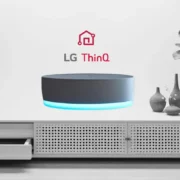KNXtoday: When did you join ABB and what does your role entail?
Lucy Han: I joined ABB exactly one year ago this month! I am based out of the ABB global headquarters in Zurich, Switzerland, and as a member of the division management team for Smart Buildings, I am responsible for driving the ambitious strategic growth plan for the building and home automation solutions (BHAS) business globally. I spearhead a global team that supports customers worldwide, and our digitally-led portfolio enables the more efficient use of energy, making homes and buildings safer, smarter, and more sustainable and people’s lives more comfortable.
KNXtoday: What is your current view of the building and home automation market and where do you see the challenges and opportunities?
Lucy Han: One of my passions is to lead the way with advanced technologies to tackle tomorrow’s challenges, particularly within the building and home automation sector. This market has experienced significant growth, driven by key factors such as increasing urbanisation, rising demand for smart and connected devices, increased awareness of decarbonisation efforts, and building legislation such as the EU’s EPBD (Energy Performance of Buildings Directive).
To ensure the success of initiatives such as Net Zero Homes and to effectively optimise energy usage while reducing carbon footprint, ‘simplicity’ and ‘smart’ are key. That means open communication protocols, interoperable devices and creating a common language for the smart building ecosystem. By offering affordable building and home automation solutions, we aim to democratise the building automation market, prioritising simplicity, interoperability, and sustainability.
In addition to technological advancements, it’s crucial to consider the practicalities of the user experience. Imagine homes where residents’ connected devices and appliances are all connected through one centralised system to save money, time, and energy. Whether from their smart device or touchpanel, the average smart home resident currently has a minimum of five Apps to manage it all. This has to change. We’re leading the way in enabling residents to monitor and control everything – from washing machines to energy and security systems – using just one App on their devices. I find the opportunity to contribute to the advancement of building automation technologies and shaping the future of smart living very exciting.
KNXtoday: What are your priorities over the next 12-18 months?
Lucy Han: Creating this simplicity for building owners and operators, as well as for the partner ecosystem will require heavy innovation and collaboration. And these two things will create a much-needed nexus of new forces.
Maximising the potential of smart buildings is a team sport, one that requires technology vendors to collaborate and share knowledge on an unprecedented scale. After all, progress is created by using already-existing technologies in a smarter way. Whether in new or existing single-family homes, multi-dwellings, commercial or industrial buildings, we are forming pioneering collaborations, and these will not only see us integrating technologies and sharing projects to the betterment of the built environment, but are also designed to frame joint innovation.
One of our priorities for the next 12-18 months will be to bring all of this to the professional installer base and to educate the market. We also want to assure the market that all of our innovations follow a standards-based approach.
For ABB, that program of activity starts with leading by example. We have been decarbonising our own buildings and factory facilities through our Mission to Zero initiative for some years – and now, we are sharing our know-how with partners and customers. We are excited and proud to be making such a contribution to today’s industry 4.0 solutions in order to fix tomorrow’s issues.
KNXtoday: How do you see the coming together of residential and commercial building technologies?
Lucy Han: In a certain sense, the technology is transversal, but the solutions are most effective when the technology is calibrated to the application. The core needs of each building cover environmental footprint, health and comfort, lifecycle cost and value, and future-proof assets. These can be translated into 7 performances that measure the quality of the building itself: connectivity, efficiency, total cost of ownership, sustainability, productivity, flexibility, and well-being. Transversal aspects common to all the required performances are scalability and modularity, which are extremely important as market demands evolve to support the trends in ‘smart communities’ and ‘smart cities’.
The needs in commercial buildings and residential buildings are very similar: to create spaces that are energy efficient by reducing energy consumption through HVAC control, lighting, and shading, at the same level of comfort and further optimised. We have to offer increased flexibility and adaptability of the systems and create spaces that are safe for everyone, and we need to provide ease of monitoring and controlling the technology. We already see technology that is currently successfully used in both segments, and we expect these to converge even more in the future. Interoperability, standardisation and scalability are key.
KNXtoday: How do you see the role of industry standards, such as KNX, in the rapid growth of the sector?
Lucy Han: The successful application of technology comes from simplicity. And this is what worldwide standards such as KNX in the home and building control market bring – simplification of the automation of building functions.
KNX is transforming the landscape of building automation through its adaptable, dependable, and budget-friendly approach to overseeing and supervising diverse building systems. The inherent interoperability and open protocol of KNX facilitate smooth integration with other systems, empowering building owners and managers to enhance control over energy consumption, safety, and comfort in their buildings.
Leveraging KNX offers our customers cost advantages across the entire lifecycle — from planning and implementation, through construction, sale, or rental, to ongoing operation and administration. This guarantees that the building remains contemporary and financially-viable in the long run, leading to a swift amortisation period.
The features of KNX can be easily and quickly tailored to meet the specific requirements and purposes of any customer space too. The system ensures energy-efficient, customised control of all electrical devices whilst simultaneously providing optimal safety and security for both individuals and property.
KNXtoday: Are there any other industry collaborations you can tell us about?
Lucy Han: Our commitment to open technologies and industry interoperability standards is ongoing. In November, for example, we announced a new global agreement to jointly deliver integrated, holistic building automation, reliable energy distribution, and energy management solutions with Samsung C&T. This willextend our portfolio for commercial and large residential developments to the property management level.
The deal signals an intention to integrate holistic building solutions, such as Samsung C&T’s Homeniq smart home platform, the ABB-free@home® system and the ABB i-bus KNX that can significantly widen potential home and building services under one property management tool. This is important because it will allow building residents to control all Samsung C&T and ABB smart home devices from a single user interface.
This partnership is a good example of how, when able to choose between the Homeniq app, the ABB-free@home® app and ABB wall panels, the new ability to manage and monitor all energy grid systems within properties can lower connection charges by reducing power peaks and accelerate return on investment from photovoltaic (PV) equipment.
We are committed to supporting deployment of KNX-enabled solutions for systems integrators and professional installers, paving the way to extended integration in installations of all sizes.
KNXtoday: And finally, what are your thoughts on KNX and Matter?
Lucy Han: Our acquisition of Eve in June 2023 is also a testament to our commitment to industry standards and positioned us as a leader in Matter and Thread technology. Eve is a pioneer in applying the new Matter connectivity standard for smart home products in residential homes and buildings with connectivity through Thread technology.
Importantly, the acquisition meets accelerating demand for safe, smart, and sustainable retrofitting of buildings. This makes the management of energy, security, and comfort in existing homes easier and more accessible to even more of our customers through flawless integration.
Eve had already begun bringing Thread technology to Eve smart home devices three years ago and today offers customers free over-the-air updates to Matter. Over time, Eve products will become increasingly interoperable with ABB’s smart home systems, such as ABB-free@home®. This means that installers will be increasingly enabled to up-sell different home automation solutions.
We see KNX and Matter as complementary to each other. Both are aiming for standardisation, interoperability and openness, and both rely on a multi-manufacturer ecosystem. It is also possible to differentiate when to combine the two technologies, for example, start by installing KNX for the core mandatory functions and then extend with wireless Matter solutions for optional sensors and sophisticated interfaces.
Reference link – https://www.knxtoday.com/2024/03/50273/interview-lucy-han-on-leading-the-way-with-advanced-technologies-to-tackle-tomorrows-challenges.html










Comments